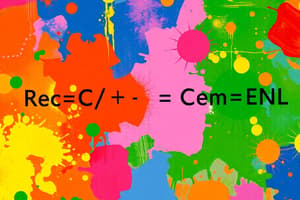Podcast
Questions and Answers
What are some real-world applications mentioned in the text related to chemistry?
What are some real-world applications mentioned in the text related to chemistry?
Environmental chemistry, chemistry of everyday materials
Match the following terms with their definitions:
Match the following terms with their definitions:
Classification = Organizing living organisms into categories based on similarities and differences Human biology = Study of the structure and functions of the human body Cells = Basic structural and functional units of living organisms Mitosis = Cell division resulting in two identical daughter cells
Match the following components with their roles in human biology:
Match the following components with their roles in human biology:
Enzymes = Catalysts for biochemical reactions in the body Organs = Specialized structures performing specific functions in the body DNA = Genetic material carrying instructions for cell processes Respiratory system = Facilitates the exchange of gases in the body
Match the following organelles with their functions in cells:
Match the following organelles with their functions in cells:
Flashcards
What is an atom?
What is an atom?
The smallest unit of matter that retains the chemical properties of an element.
What is the Periodic Table?
What is the Periodic Table?
A tabular display of the chemical elements, organized by atomic number, electron configuration, and recurring chemical properties.
What are Chemical Reactions?
What are Chemical Reactions?
Processes involving the rearrangement of atoms and molecules to form new substances.
What are States of Matter?
What are States of Matter?
Signup and view all the flashcards
Study Notes
Exploring Chemistry in Year 8: Atoms, Periodic Table, Chemical Reactions, and States of Matter
In Year 8, students dive into the vibrant world of chemistry, where they learn the building blocks of all matter, the secrets behind chemical reactions, and the fascinating transformations between states of matter. Let's journey through these four crucial concepts, uncovering the essentials of IGCSE Chemistry.
Atoms
Atoms are the fundamental particles that make up everything around us. Each element is unique, identified by its atomic number, which corresponds to the number of protons in its nucleus. We also discover that atoms can bond together to form molecules, which are the basic units of chemical compounds.
Periodic Table
The Periodic Table is a systematic arrangement of elements based on their atomic number, electron configuration, and chemical properties. By studying the Periodic Table, students learn to predict the behavior of elements and identify patterns in their properties. For example, we can observe the trends in atomic size, ionization energy, and electronegativity as we move across a period or down a group.
Chemical Reactions
Chemical reactions are the processes where atoms are rearranged to form new substances. Students learn the concept of balancing chemical equations and identify the factors that influence the rate and extent of chemical reactions, such as concentration, temperature, and catalysts. They also analyze the various types of reactions, including synthesis, decomposition, combination, and displacement.
States of Matter
States of matter—solid, liquid, gas, and plasma—are distinct forms of matter with characteristic physical properties. Students learn the differences between these states and explore the concepts of phase transitions, intermolecular forces, and colligative properties. Understanding the behavior of matter at different states is also critical for comprehending the changes that occur during chemical reactions.
Putting it All Together
Throughout the year, students integrate these four concepts to develop a deeper understanding of chemistry. For example, they learn about the role of atoms in the formation of compounds, the relationship between the Periodic Table and chemical properties, the importance of chemical reactions in daily life, and the transformations between states of matter.
To make learning more engaging, students can participate in hands-on experiments, analyze data, and relate their understanding to real-world applications, such as environmental chemistry and the chemistry of everyday materials.
By mastering these fundamental concepts, students build a strong foundation in chemistry, opening up the door to further exploration of more advanced topics as they progress through their studies.
Studying That Suits You
Use AI to generate personalized quizzes and flashcards to suit your learning preferences.




